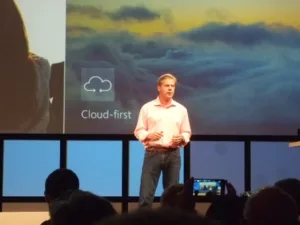Microsoft’s keynote speech, by Nick Parker (corporate VP of the OEM division), was really just an excuse to show off the new Windows 10 devices that have been launched in recent months, as well as showcase one or two that are still to come.
The event was opened by Jens Heithecker, executive director of IFA. He said, “The display is our primary interface…but the software driving it is also important… and there’s no software more widely used than Windows”.
Parker came on-stage to say that Microsoft aims to “empower every organisation and person on the planet to achieve more”. The company wants to build platforms and services for the new mobile- and cloud-first world.
509 million Windows devices will be sold in the next year, and there are 1.5 billion Windows users in the world today – and more than 1 billion using Microsoft services. 75 million devices are running Windows 10, one month after the OS was launched, and 90,000 unique device models have been upgraded.
After a break to show off some of the features of Windows 10, Parker came back to tell us about some of the new devices built for the OS. Many of these feature dual-array microphones, for use with the Cortana virtual assistant.
In education, there was Acer’s Aspire One Cloudbook – which, as Parker calmly pointed out – “works both offline and online”. Or, as a fellow audience member put it more succinctly, “Take that, Google Chrome”. Another product for students is Lenovo’s Ideapad 100S: a 14″ notebook with an Intel Atom processor, for $230.
For business users, there are the HP Elitebook Folio 1020 and Lenovo Thinkpad Yoga 460 – or a brand new device announced at the keynote, a new version of the Dell Latitude 11 notebook.
The internet of things is a growing market, and Windows is there to power the segment: from ATMs to medical devices. One such model is Panasonic’s Toughpad Fz-M1 tablet: a rugged device with IP65 protection. Another is a Toshiba product called the Environmental Data Logger: a dongle-like unit that can hold up to 20 sensors, with a battery life of up to six months. Data collected can be sent to a gateway or satellite uplink; the idea being that it can be used to, for example, monitor the state of a precious cargo remotely.
 AIO PCs are seeing more adoption, and Parker demonstrated the Dell Inspiron 24, with edge-to-edge glass and the ‘Windows Hello’ camera; this can be used for authentication, by recognising the user. Another device is Asus’s Zen AIO S, which also features edge-to-edge glass and the Hello camera. Asus’s unit has GTX 960 graphics and an optional UltraHD display, with prices starting at $1,000.
AIO PCs are seeing more adoption, and Parker demonstrated the Dell Inspiron 24, with edge-to-edge glass and the ‘Windows Hello’ camera; this can be used for authentication, by recognising the user. Another device is Asus’s Zen AIO S, which also features edge-to-edge glass and the Hello camera. Asus’s unit has GTX 960 graphics and an optional UltraHD display, with prices starting at $1,000.
Finally was one of the fastest-growing IT segments today: two-in-one, or hybrid, PCs. Some of the existing models included the TrekStor Volks-Tablet 4 (€250) and HP Pavilion 15.
Parker also showed off two products that were launched at IFA. The first was Toshiba’s Satellite Radius 12 (Toshiba Knows the Importance of Colour), and the second was new Asus ROG model. Designed for gamers, this 17.3″ notebook features a gaming (anti-ghosting) keyboard, Skylake processor, GTX 980 graphics and an anti-dust cooling system. Thermal vents on the rear take heat from the CPU and GPU. It will start at $1,400.
Finally was a brand new Toshiba hybrid – so new that it hasn’t been named yet, “and I probably shouldn’t be showing it”, said Parker. However, he didn’t give much away! Only the fact that it is quite a small detachable and Toshiba will bundle it with a stylus.

